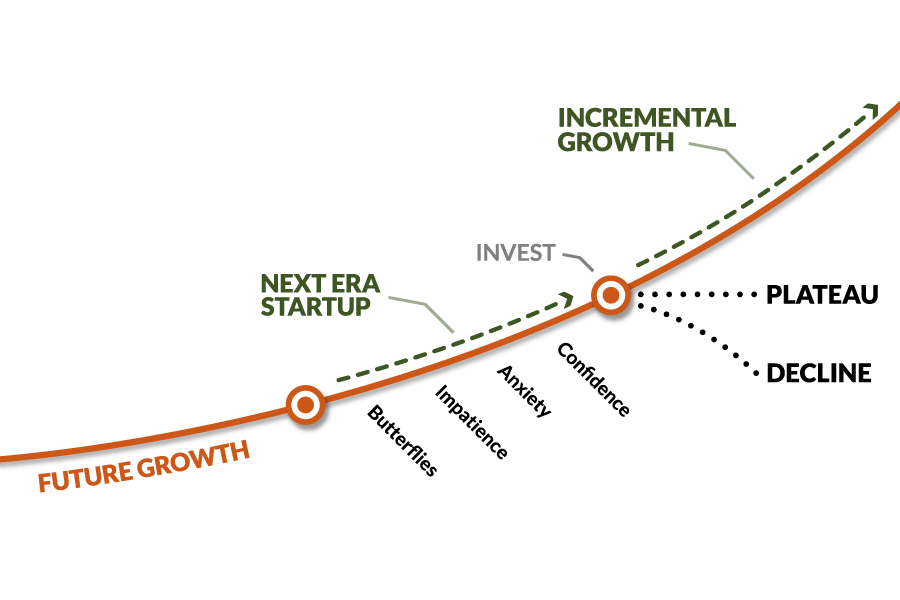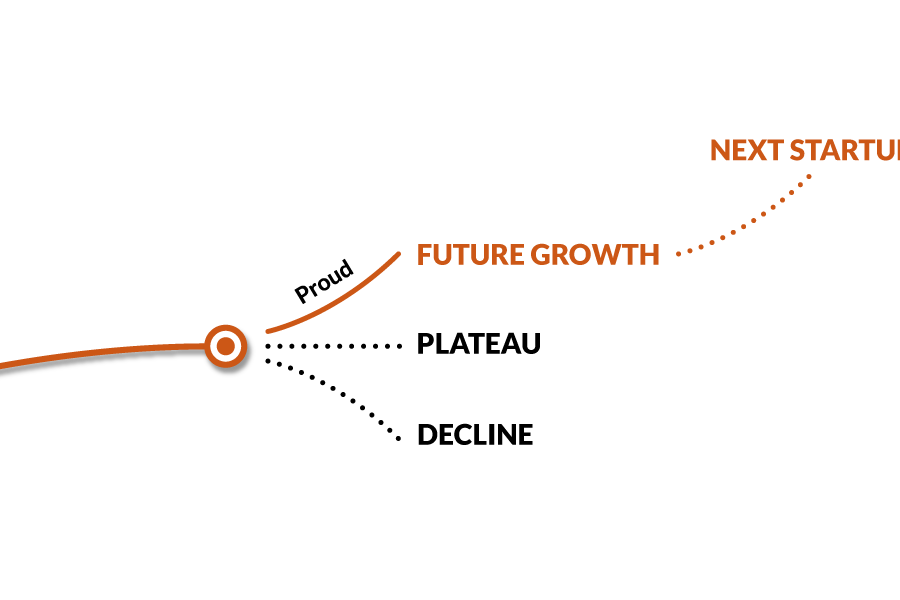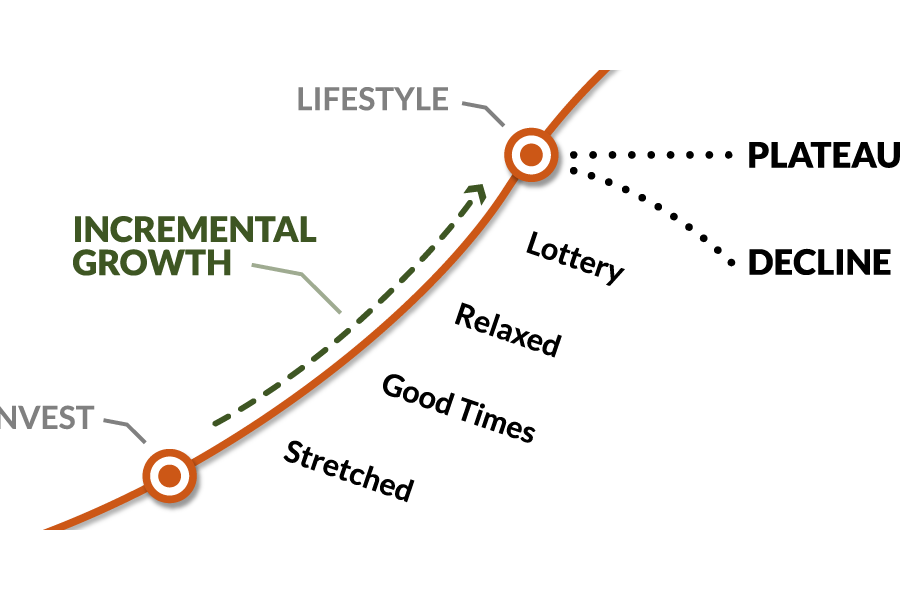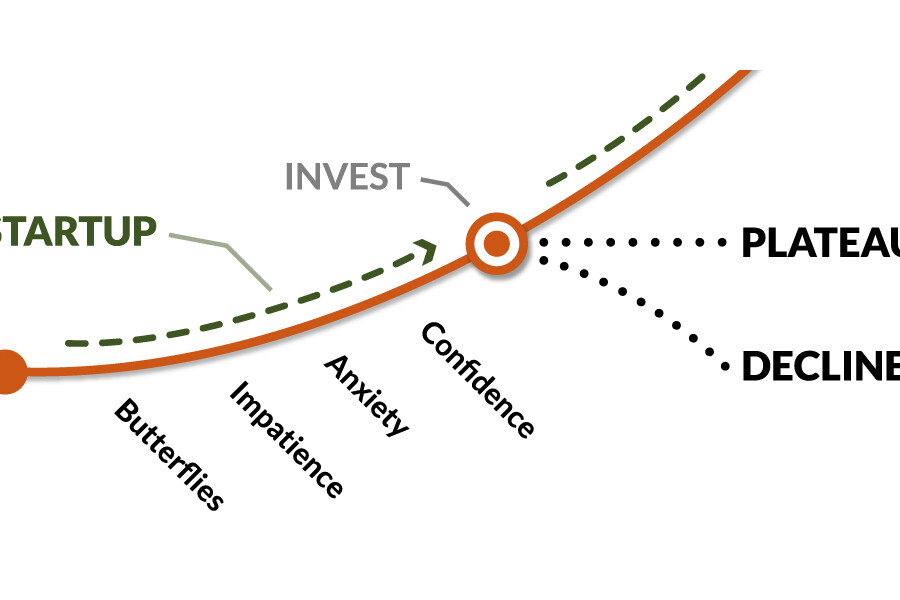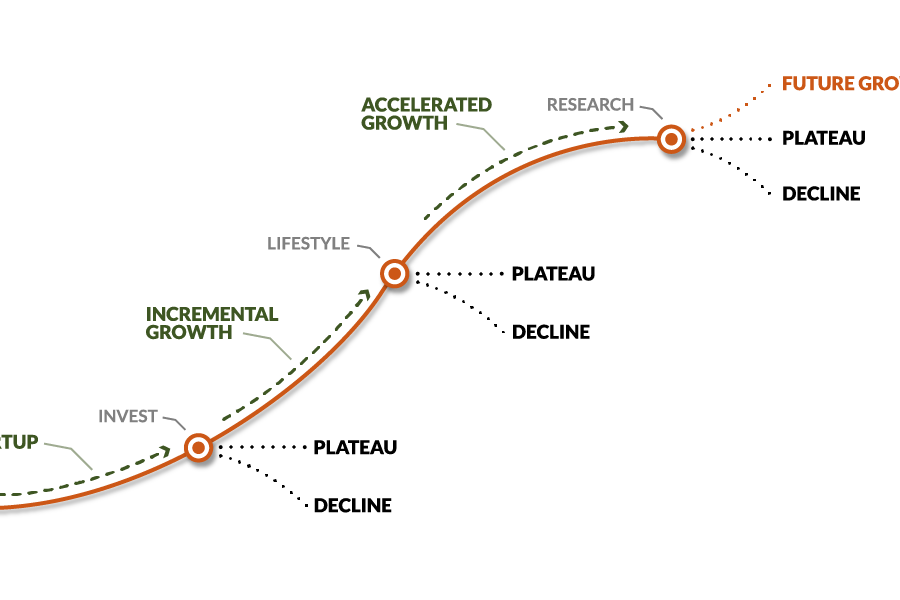The Hidden Pitfalls In Accelerated Growth You’ll Actually Experience
Following on from the tipping point at the Lottery stage of the Incremental Growth phase, the investments made drive the rapid expansion that creates the Accelerated Growth phase.
After the great feelings from the Relaxed and Lottery stages, the feelings felt during this rapid growth are primarily surprise, both good surprise and bad. Each section will delve into the associated behaviors, decision-making tendencies, and actions required for progression.
Frustrated: The First Surprise
The bill has come due. All investments previously deferred must now be paid. The cash flow impact builds, and there is a change in feeling good from having increased revenue to feeling bad as now the company must bring in that revenue to pay the bills.
Pressure and frustration build! Revenue is rising quickly, but not quite as fast as planned. Some of the infrastructure is struggling, and some clients complain about their experience.
When the owner or leader arrives, a line of people is waiting to discuss issues which need resolution.
The frustration deepens as the challenges continue, and the business strain is often taken home.
The company is now starting to run the leadership more than they run the company.
Behavior: Failing Communication
The frustration leads to impatience, irritation, and a tendency to blame others. The communications tend to take on a different tone than during the last phase. The culture begins to turn, and a culture of control starts to germinate. This starts with the owner or leadership, quickly moving throughout the organization. New hires rapidly adopt this developing culture.
Collaboration reduces as team cohesion evaporates. The team focuses on what they must do to avoid being blamed.
Decision Making: Slows Down
In the face of frustration, decision-making starts as reactive and hasty, primarily to eliminate the line of upwardly delegated problems presenting themselves each day. Bigger decisions become ‘leave it with me’ or ‘I will get back to you,’ which becomes the order of the day unless a decision must be made immediately.
Unless it is broken and needs repair, decisions become delayed as there is seldom enough time, energy, or desire to evaluate the problem properly and make it. Confidence in the business and the team can be eroded.
Action to Progress:
To dampen the frustration and reduce its impact, leaders can:
- Understand the business cycle and plan to get ahead of it.
- Communicate with the team and explain the business cycle.
- Acknowledge the impact of growth and the change it is forcing.
- Agree on the expectations on how to manage this stage of the Accelerated Growth phase.
- Reconnect to the vision.
- Acknowledge the cultural impact and the behaviors that have developed.
Example: Manufacturing Business
A manufacturing company that continued to experience growing demand for a new product line faced frustration when its production facilities struggled to meet deadlines with high levels of substandard products.
The management team meetings became one large argument, with the sales manager blaming the delivery manager, who accused the production manager, and the production manager blaming the sales manager for unrealistic promises. The cycle went on day in and day out.
Stressed: Closed Doors
The stressed stage comes on the heels of being Frustrated. Growth continues either faster or slower than expected. The business continues to struggle with the impact. Frequently money is thrown at the problem of getting goods and services out to the customer or client.
Revenue continues to rise, yet profitability rapidly declines and often moves to loss. Staff are feeling overworked, working harder and less efficient.
Behavior: Heads Down, Doors Closed
During this stage of the Accelerated Growth phase, the behaviors initially exhibited in the Frustration stage amplify.
Employees continue to delegate decisions and issues upward. The owners and leaders feel like the whole world is pressing down on their shoulders, and loneliness sets in.
Blame continues and gets worse with decisions taking longer to be made, and meeting avoidance starts to develop. Employees keep their heads down and avoid interactions with the owner, not wanting to be chewed out. Where can people go into an office or a conference room and the door gets closed with the implication of do not disturb!
Sometimes, the owner or leadership tries to work from home to avoid all face-to-face interaction with the team.
Productivity and focus decrease, and things take an increasing amount of time. Customer promises are broken, customer issues continue, and staff sickness increases.
Decision Making: Avoided
The increasing stress levels contribute to analysis paralysis or general decision-making avoidance.
Decisions are often poor, and exacerbated by decreased focus and a negativity bias, remembering that the decisions to drive the current growth and revenue levels have not worked.
Individual leaders and employees are protecting and looking after themselves, avoiding anything that could come back and bite them and pushing nearly every decision to the ownership.
When decisions have been made and have not worked out exactly as people expected, blame and covering their backside is the order of the day. The owner and leadership often start taking tasks back as it is easier to do it themselves than handle all the hassles.
Action to Progress:
To manage the stress stage effectively, leaders need to:
- Prioritize self-care, including exercise and sleep.
- Stay connected to the business. There is a tendency to want to distance oneself from the company’s problems.
- Understand that it is a stage of growth that can be managed through.
- Reconnect to the ‘Why’ behind the vision and prepare for getting business through this period of significant change.
- Review the organizational structure and what people are responsible for. Understand where overwork is, and where automation and transformation can relieve it.
- Manage the urge to do it all.
Example: Manufacturing Business
Returning to the manufacturing business introduced in the Frustrated stage. The management team has moved to being stressed. Every member hated attending the daily meetings and came ready for the fight with evidence of the other team members’ failures.
When not in the meeting, they retreated into their offices, avoided phone calls, and asked for emails they could review or use to push a point. The sales manager occasionally went out with their salespeople to clients, often to take the heat for the issues of delayed delivery or mistakes. The response was typically to push an urgent order with an expectation of delivery the next day and pressure the owner to agree to push it through to save the customer regardless of what the production had planned and the delivery by courier.
Every day was stressful, and the management team had developed a pattern. The Production manager expected to get a customer urgent job. The owner could see that they were losing money on these orders but could not see how to address it after all these customers had helped them to grow and scale to this size.
Disillusioned: When Will This End
As the Stress increases, there is a point where the stage transitions to that of Disillusioned. The owner would happily sell the business if they could get a good price to relieve the Stress and pressure.
Business owners at this stage often ask, how did the business get here? 2 years ago, the business had made $15 million, with $2 million net profit, one year ago, it made $16 million and broke even. This year, it made $18 million, and has lost $1 million net.
Why aren’t people doing their jobs, always sick or leaving? Labor relations are poor, and why do accidents happen now?
The focus moves to reducing costs, considering if the team can do more, and occasionally responding to the many emails asking them if they are interested in selling.
Behavior: Head in Their Hands
The gap between the original expectations and reality continues to widen as the behavior has developed into cynicism, detachment, and a lack of enthusiasm. For some, a feeling of despair emerges.
Unless very urgent, decisions take six-plus months, if at all, to be made. The owner and leadership would do anything else other than make a decision. Sometimes they can be found fixing the printer, the first machine in the shop, or giving unsolicited advice on how to make something on the production line. This helps them feel like they are adding value to the business as the business feels like it is running them, and they have a sense of having to do it all themselves.
Staff leave, and the culture is initially negative but can quickly turn toxic if not addressed.
The behavior is completely reactionary and often likened to playing whack-a-mole. Communication is cautious and formal, often run through HR before sending.
Decision Making: Stalled
When disillusioned, leaders exhibit a pessimistic outlook and are highly risk averse and indecisive. They often look back to the Good Times or Relaxed stages, wishing they were back there.
There is also increasing pressure to grow further and to change. Concerned about making mistakes, the indecisiveness progresses them to the next stage: Research, where they look for utopian solutions to fix all the problems and challenges.
Action to Progress:
While this is a normal stage, the time the owners, leadership, and the business stay can be managed. In addition to the actions highlighted in the prior stages of the Accelerated Growth phase, management can:
- Acknowledge the situation and mood inside the business without blame.
- Redesign and implement the next phase of culture to the future of the business, its values, or how they are expressed and the behaviors underpinning them.
- Manage the staff transition for those that do not want to change to the positive culture is implemented, and resistance is pushed through.
- Look to restructure the business, what needs to be changed, what roles are no longer applicable, and what can be simplified and automated.
Example: Manufacturing Business
Returning to the manufacturing business introduced in the Frustrated stage. The management team has moved beyond stressed, to completely disillusioned. They are all looking for other jobs, but the management of the business has a toxic reputation. There was high turnover within the sales team, and sickouts were increasing with the delivery and production staff.
The business received lowball offers to buy them from their competitors, circling like a group of vultures.
The management team, faced with their reality, decided to stop arguing with each other and understand how they could work better together and bring the business back to life.
They agreed to get some help to help them work collaboratively again. After understanding what was driving each area of the business, they reset their context to change the expectations they set with their customers – the previous one was the speed of order to delivery, understanding that the production was about maximizing efficiency, and that meant that orders took longer than promised by the sale team. Finally, they worked with the delivery team to plan the routes more closely with the drivers’ operations.
This allowed them to enter the lost stage with a sense of accomplishment.
Lost: Research Stall
The Lost stage is so-called because the organization starts to do something about moving the business forward. As it enters disillusioned and starts looking for why the company is not working as it once did, it can get absorbed with research, similar to analysis paralysis. The leaders explore how to dig themselves out.
This research is not logical when conducted with Stress, disillusionment, and despair. It can appear to the staff that it is another of the owner’s or leadership team’s great ideas, like throwing mud against a wall.
This stage of the Accelerated Growth phase is a pivotal turning point as to whether the business will move into the Future Growth phase, the Plateau, or the company enters the Decline phase.
Behavior: Feeling Lost
As they enter this stage, the team often lacks clarity regarding future strategy and direction. They are working on the problem but focused on the day’s issues. It is initially hard for them to recall what it was like to look toward and plan for the future as they did earlier.
Their behavior can be one of trial and error, hoping that they have found the solution and it will reignite the stalled business and get it back into profitability.
As the solution is understood, the lack of whacking moles daily can make the team feel lost as it had become an all-consuming behavior, and the larger the number of moles whacked, the more a sense of accomplishment was felt.
Decision Making: Trial and Error
Initially, decisions are mostly deferred at this stage, hoping the issues will resolve themselves.
Once the choice has been made to change the situation, research starts, but it is often from more emotive decisions that are made with the hope of solving the problem. As these fail, it can feel like there is a repeating cycle of trial and error as they address one specific issue at a time and have not addressed the causes of the many particular issues.
Action to Progress:
To regain a sense of direction, leaders can:
- Reconnect to why the business was created and its importance to the founder.
- Review the vision that drove the investments during the Lottery phase. Can it be achieved?
- Review what organizational structure changes are required to achieve the planned growth and how many steps will it take.
- Understand the organization’s capacity, where it has too much and where it has too little, and what it will be at the vision.
- Assess the Management and Leadership capabilities and where they can be enhanced through training or where a gap needs recruitment.
- If not addressed in prior stages, redesign, evolve, or realign the organizational culture and proactively manage it.
Example: Manufacturing Business
The team has become more comfortable with their agreements and a new working method. They no longer spend nearly all their time and energy dealing with the fallout and arguments between them.
Initially, they felt lost and a little uncomfortable. What would they do each day? Now having the energy to undertake further research to gain the market share they had expected before becoming completely internally focused.
By researching and building their plans from where they are, which they now know, they were able to see how they could achieve the vision that launched all the prior investments. They were able to build a plan that showed the sequence of steps required to build out the business’s capacity and fill it up without further stressing it or creating the bottlenecks that had previously existed.
Conclusion
The Accelerated Growth phase can be a roller coaster if the organization is well funded. For most, it can be an unpleasant experience as the organization changes. Not being aware of how this phase has the opposite impact to the last phase as the revenue grows has surprised many business owners and their leadership teams.
Leaders can forge a path toward continued success and growth by acknowledging, confronting, and getting ahead of these challenges so that they can quickly move through them as they can come up.










